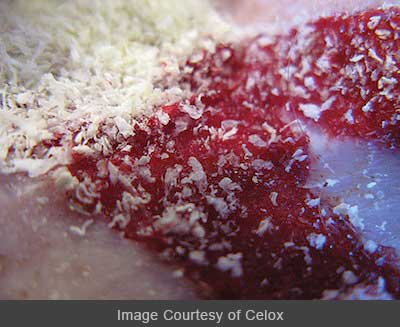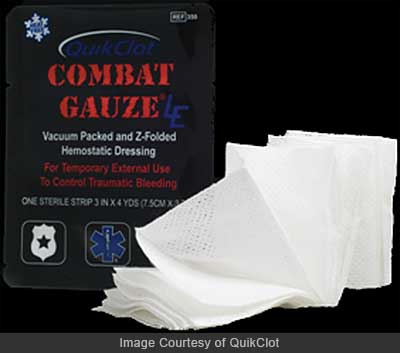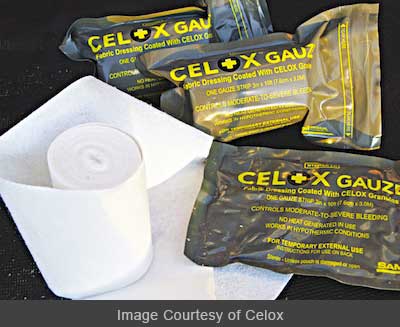
SHWAT™ is about more than just cool guns. We bring you the knowledge you need to be successful in your hunt. In this case we are bringing you information that could potentially save your life or a friend’s.
According to data from the National Shooting Sports Foundation (NSSF), there were approximately 8,122 hunting related injuries in 2010. Over 6,600 of these were associated with tree stands. If you think it couldn’t happen to you, just ask Vice President Dick Cheney’s hunting buddy or former pro cyclist Greg Lemond. They both were accidentally shot while hunting.
Knowing what to do when things go sideways is always a good idea. It’s especially a good idea when you are engaged in an activity that takes you to places where emergency medical services may take a long time to arrive. In this article on tactical first aid, we will address one of the latest tools to employ when the animals aren’t the ones bleeding.
Hemostatics are a new and innovative way to stop bleeding. Used primarily in combat and some EMS/fire departments , they can be a valuable additional tool in your tool kit. Hemostatics hit the military market in the early 2000s. They did not become commercially available until five or six years ago.
There are several types of hemostatics on the market today. Every brand has pros and cons. It will be up to you to do research, and decide which one is right for you. This article is meant to serve as a starting point that research.
Many of us are familiar with QuikClot from Z-Medica. Quikclot is currently being fielded by our military and others around the world. Early generations were made from Zeolite, a form of volcanic rock. It helps to absorb the water portion of blood making the concentration of platelets higher, thereby promoting clotting. QuikClot now uses a Kaolin-based product for better performance.
Other companies like Celox, use chitosan. It’s derived from a complex carbohydrate found in chitin, common to shellfish. Don’t worry, if you are allergic to shellfish, you will be okay! Others in the field use algae-based products or synthetic potato starch derivatives.
Early versions were in granular or powder form that were dumped into the wound to start the clotting process. According to some reports, early versions did cause some pain, discomfort, and a severe burning sensation. Given the choice of a painful reaction or bleeding to death, I’ll be happy to take the first option.
Thankfully, newer versions no longer contain the caustic components, resulting in a more pleasant bad experience. You read that right.
Now, the hemostatics are built directly into the trauma bandages. They can be applied like regular bandages or packed in the wound as a “Z fold”, back and forth, side to side while maintaining constant pressure. Another version is a tampon-like applicator with the hemostatic bandage in it, which allows it to be used in deep-penetrating-type trauma or even severe nose bleeds.
As always, the keywords for bleeding are “bandage and pressure.” One will not work without the other. Hemostatics just help the process along.
 So when do we use hemostatics? Any scenario where you find yourself or a loved one bleeding profusely is the right answer. And, I’m not referring to really bad paper cuts, broken nails, or a laceration that might need a few stitches. I’m talking about serious deep lacerations or penetrating wounds with pressurized bright red blood squirting from it.
So when do we use hemostatics? Any scenario where you find yourself or a loved one bleeding profusely is the right answer. And, I’m not referring to really bad paper cuts, broken nails, or a laceration that might need a few stitches. I’m talking about serious deep lacerations or penetrating wounds with pressurized bright red blood squirting from it.
As always, the first line of defense is pressure, and lots of it. If you are properly prepared and the first bandage you have access to is a hemostatic agent, place it on quickly and continue pressure. If you weren’t prepared or lucky enough to have a hemostatic ready, continue pressure with original bandage until the hemostatic bandage is ready.
This next part is vital. There are two different bandaging scenarios that been used for years. First, we were taught to place a regular bandage in the wound and apply pressure. If it still bleeds, place another regular bandage on top of original and apply more pressure. This thinking was to keep the current and active clotting process inside the wound.
If you were to take them all out and replace them with fresh bandages, the long clotting process would have to start over. Also, if you have a single, large, and bulky dressing, removing and replacing it would force the process to start over as well.
Now that we have hemostatics, we can remove the original bandage, very briefly, of course, and place a hemostatic infused bandage in its place. The active agents need to start working as close to the bleeding site as possible. Once the hemostatic agent is applied, again, as always, apply pressure! Hold that pressure for a few minutes. You should start to see a slowing of the bleeding right away.
Within a few minutes, according the manufacturers, the bleeding should stop. You should immediately secure the hemostatic bandage with some sort of additional dressing, or wrap it tightly so you don’t interrupt the clotting process.
 Paramedics and ER doctors are aware the companies are marketing hemostatics to outdoorsmen. QuikClot has a Sport version and Celox has a First Aid version available for purchase. All versions, including the “combat” and “sport” types are available for civilian purchase. If you are interested in this type of product, please take the time to do your research, and find what works best for you.
Paramedics and ER doctors are aware the companies are marketing hemostatics to outdoorsmen. QuikClot has a Sport version and Celox has a First Aid version available for purchase. All versions, including the “combat” and “sport” types are available for civilian purchase. If you are interested in this type of product, please take the time to do your research, and find what works best for you.
Here comes my two cents: Just about every IFAK (Individual First Aid Kit) on the market comes with some sort of hemostatic agent so it pays to know how and why they work and when to use them. If and when I am injured and the need presents itself, I will most likely use the hemostatic agent.
What I personally don’t like about some companies’ claims is that their tests are done in a controlled setting laboratory. A pig is sedated and medicated for a humane study. To get to the femoral artery, they use a surgical scalpel to cut all the way down and expose the artery. They then use an oval-shaped punch to rupture the femoral artery. They let it bleed for a while until it reaches a certain blood pressure and then they start using the hemostatic to test its effectiveness. Most of the time they are filming with a time lapse camera to see at what time the desired effect has taken place.
Now, I’ve been in the field a while, and I’ve never come across such a perfect setting. Usually with gunshot wounds, the entrance and exit holes can be very jagged and uneven. Most times, large bones and bone fragments are often in the way making it difficult to apply the hemostatic correctly. Also the patient is not calmly sedated and medicated — they are screaming their heads and flopping around!
Also, please be aware of some simple facts: The FDA does not have to regulate the claims made by each hemostatic manufacturer like they do with new medications. Medical literature is also very conflicting as to which product is the best. Very few scientific, objective controlled studies have been done to verify the claims made by the different companies. Each company has their own testing and evaluations which are usually made available on their website.
Done properly, hunting is a pretty safe activity. According to the NSSF, SHWAT™ founders Jonathan and Stephen are 25 times more likely to be injured while out cycling than they are hunting. For that matter, if you are into golf, you are roughly three times more likely to sustain an injury than I am while hunting. But stuff happens. When it does, will you be ready? Will you have the mindset and the tools to deal with the situation?
Prepared or unprepared? Trained or untrained? Which one are you?
S.H.W.A.T Medic

